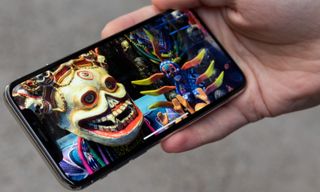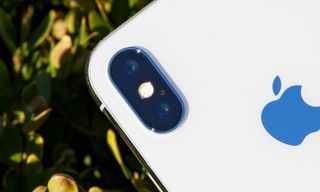The Next iPhone X: What Apple Should Kill (and Add)
Apple is constantly mulling over changes to its iPhone. Here's a look at what it can remove from future versions of the phone — and what it might be able to add.
One thing I've learned in writing about Apple in the era of Jonathan Ive as chief designer is that the company's products will always aspire to get thinner, lighter and simpler, striving for the ideal of being nearly featureless slabs of glass and metal. (The monolith from 2001: A Space Odyssey, that's an Apple product if ever I saw one.)

Apple made some major changes to the iPhone industrial design with the iPhone X, so we might not expect to see any revolutionary changes for a few more years. But every fall Apple releases new iPhone models, and with them an opportunity to keep creeping ever closer to that ideal. So what might this fall bring?
Targets for elimination
Back in my days at Macworld, we used to joke that Steve Jobs' turtleneck didn't have any buttons, and in his dreams, none of Apple's products had them, either. Certainly Jonathan Ive's designs have always pushed toward minimalism whenever possible, whether it's dropping the buttons from the iPod Shuffle (they came back) or the headphone jack and home button from the iPhone X (they're probably gone forever).
MORE: iPhone 2018 Rumors: What to Expect
So it's worth looking at today's iPhone and asking ourselves what ports and buttons are the most likely targets for elimination? Unfortunately, there's not much left. You need a few hardware buttons to kick off certain actions where the software isn't responding: powering on and off, for instance.
The person currently holding the job of Apple Button-Remover-in-Chief has a couple of juicy targets.
Could Apple afford to kill the volume buttons, the ring/silent switch, or both? As always, there are plenty of arguments about why those items are vital and can never be removed from a phone, but time and again, Apple challenges those arguments. Many headphones have their own hardware volume controls — though I'll point out that Apple's own AirPods don't — and when you're playing audio you can get to on-screen volume controls with a single tap. I'm a huge fan of these buttons — squeezing them while the iPhone's still in my jeans pocket is my preferred way of adjusting volume, in fact — but you could get rid of them.

The ring/silent switch, likewise, is a convention of smartphones that ensures you can quickly enter a social context where phone noise isn't allowed. You could argue, though, that holding down the volume-up or volume-down buttons could turn muting on and off. As a result, it feels like Apple could afford to lose some — but not all — of these buttons. If I had a vote (which I don't), I'd probably choose to eliminate the sleep/wake button and the mute switch, leaving only the volume up/down buttons. But I could also easily see an argument for the reverse. The person currently holding the job of Apple Button-Remover-in-Chief has a couple of juicy targets.
I've heard a lot of talk about the elimination of the Lightning port from the bottom of the iPhone, but this feels like a bridge too far to me. Going from one wired access point for external accessories and charging to zero is a big step.
If the operating system on an iPhone gets utterly hosed, you can attach a Lightning cable and completely wipe and reset the device. Compare that to the Apple Watch: Screw something up with that smartwatch, which has no physical connections to the outside world, and you have no recourse but to bring it to Apple for service.) And while wireless charging is something I've come to embrace, it's hard to imagine it as the only method, since it's slower and less efficient than wired charging. Maybe someday wireless chargers will be ubiquitous and it won't be an issue any more, but we're not anywhere near that point yet.
Targets for addition
The iPhone X introduced the "notch" — a curved sensor housing cut into a screen that otherwise lacks a traditional phone bezel. Apple has embraced the notch, making it a signature part of the iPhone X's identity, and its competitors are now copying it, like so many Eastern Bloc blue jeans.
Soon, Apple will begin the process of trying to reduce the size of the notch or eliminate it altogether, because that's Apple. It's hard to imagine it will change this year, though — in fact, it's more likely that Apple will maintain the size and try to upgrade the components in the TrueDepth camera system. If the rumors are true, Apple will also attempt to bring the "notch" to the mainstream of the iPhone line through an updated version of the iPhone 8.
For this fall, my guess is that we'll see an updated set of sensors in the notch that improve Face ID's speed and accuracy, as well as the quality of the depth maps generated by the sensor when it's in selfie mode.

I'd also expect another step forward on the quality of the rear cameras, though the laws of physics seem to suggest that the bump on the back of the iPhone camera is here to stay. You've got to think that the camera bump just kills Apple's designers. But when it comes to Apple’s priorities, making the device thinner and packing in better technology and content inside seem to win out over finding a less obtrusive way to gather light and take great shots. Maybe someday Apple will revolutionize tiny smartphone sensors... but that seems a while off yet.
Finally, two less visible features that are still a huge part of the iPhone's exterior hardware are those that fight against the iPhone's natural enemies, gravity and water. Apple's made huge strides in this area, with the iPhone X and iPhone 8 rated IP67 for splash, water and dust resistance, and with regular improvements to the shatter resistance of the glass on the iPhone screen.
It feels like every year, Apple adds more water and dust resistance to its iPhones, and it makes sense — water damage is one of the biggest killers of iPhones. Today's iPhones are pretty good in this regard, but the dream would be a true claim of waterproofing, a la the Apple Watch. And just as soon as Corning invents a brand of Gorilla Glass that won't crack when you drop it, I'm pretty sure Apple will buy all of it.
Image Credits: Tom's Guide
Sign up to get the BEST of Tom’s Guide direct to your inbox.
Upgrade your life with a daily dose of the biggest tech news, lifestyle hacks and our curated analysis. Be the first to know about cutting-edge gadgets and the hottest deals.
Jason Snell was lead editor of Macworld for more than a decade and still contributes a weekly column there. He's currently running the Six Colors blog, which covers all of Apple's doings, and he's the creative force behind The Incomparable, a weekly pop culture podcast and network of related shows.
